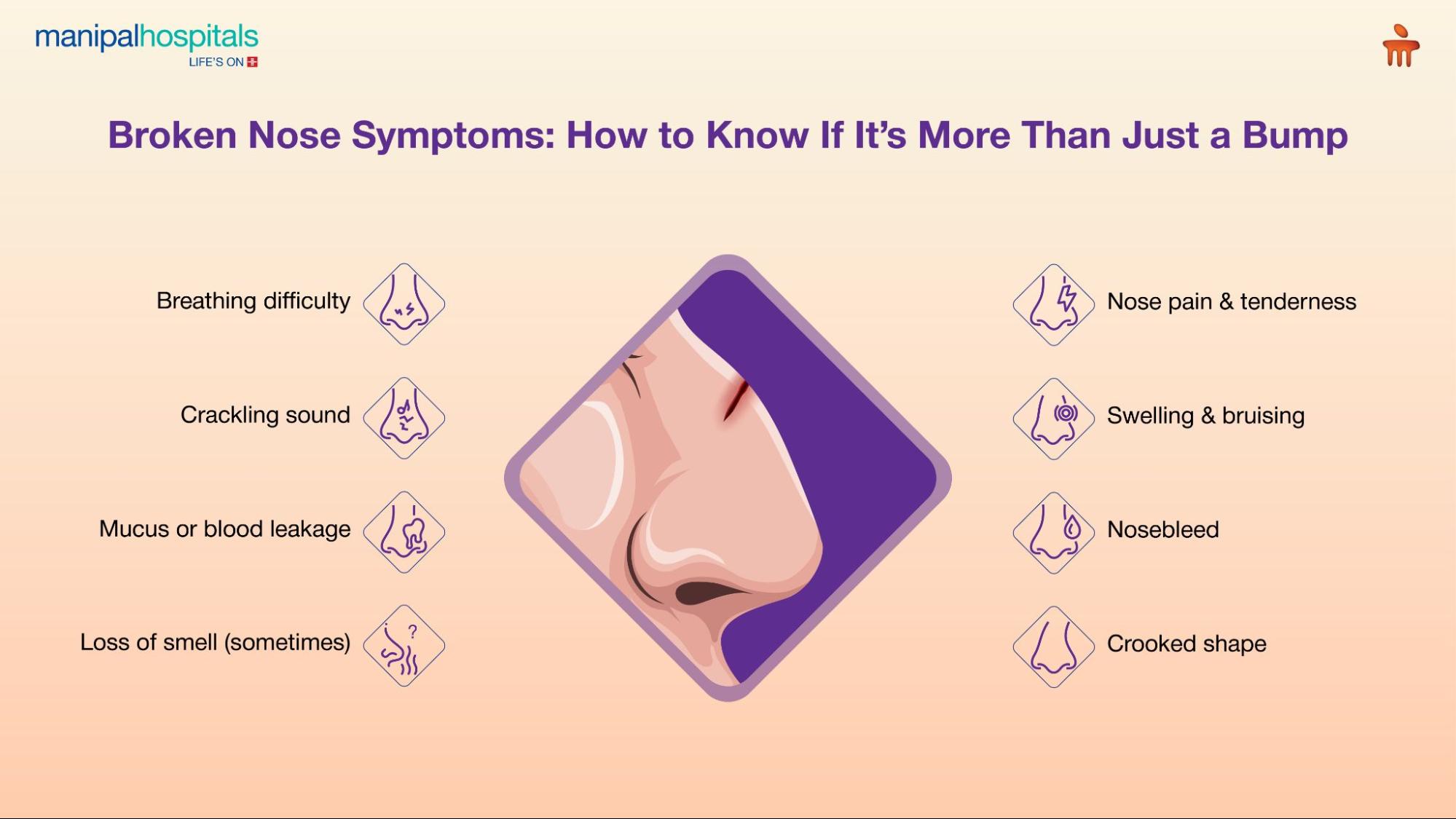
A broken nose, also known as a nasal fracture, is one of the most common facial injuries. Whether it's due to a fall, an accident, a sports injury, or an unexpected bump, an injured nose can be painful, distressing, and in some cases, may require medical intervention.
Although a broken nose might seem minor compared to other injuries, it can affect both your appearance and your ability to breathe properly. If not treated correctly, complications such as chronic nasal congestion, persistent pain, or a deformed nasal bridge can arise.
In this blog, we will guide you through the symptoms, types, diagnosis, and treatment options for a broken nose, helping you understand when it's just a bruise — and when it's something more serious.
Synopsis
What is a Broken Nose?
A broken nose is a fracture or crack in the bone or cartilage of the nose, usually in the bridge (the bony upper part). The injury often results from trauma — such as sports accidents, physical altercations, road traffic accidents, or simply falling face-first.
Depending on the force and direction of the impact, the injury can range from a minor crack to a displaced nasal bone that alters the shape of the nose.
Common Causes of a Broken Nose
A nasal fracture can happen in a variety of ways, including:
-
Contact sports like football, boxing, or martial arts
-
Falls or accidents that impact the face
-
Road traffic accidents
-
Physical assault
-
Collisions during everyday activities, like bumping into a door or wall
Broken Nose Symptoms: What to Watch For
Recognising broken nose symptoms early can help prevent complications and guide timely medical attention.

Here are the most common symptoms of a nasal fracture:
-
Pain or tenderness around the nose or under the eyes
-
Swelling of the nose and surrounding areas
-
Bruising, especially under the eyes (commonly known as "raccoon eyes")
-
Nasal deformity – your nose looks crooked or misaligned
-
Nosebleed after injury
-
Difficulty breathing through one or both nostrils
-
Crunching or cracking sound when touching the nose
-
Mucus or blood drainage from the nostrils
In some cases, a broken nose may also lead to loss of smell or blockage of the nasal airway, especially if the septum (the cartilage dividing the nostrils) is also affected.
Types of Broken Nose Injuries
A broken nose isn't always straightforward. It can vary in complexity:
-
Simple Fracture: This is a clean break with minimal displacement. The bone may be cracked but remains aligned.
-
Displaced Fracture: Here, the nasal bones are misaligned, resulting in a visibly crooked nose or difficulty breathing.
-
Comminuted Fracture: A more severe type where the nasal bone breaks into several pieces.
-
Septal Fracture: Injuries that involve the nasal septum, which may cause obstruction or a deviated septum.
Some fractures are open (with wounds) and others are closed (without external wounds), which also affects the treatment approach.
When to See a Doctor?
Seek immediate medical care if you experience any of the following:
-
Uncontrolled nosebleed that lasts longer than 10-15 minutes
-
Persistent pain or swelling
-
Noticeable deformity or crookedness in the nose
-
Clear fluid leaking from your nose (could indicate cerebrospinal fluid)
-
Recurrent sinus infections following trauma
Even if your symptoms seem mild, it’s a good idea to consult a doctor to rule out internal damage or nasal obstruction.
Diagnosis: How Is a Broken Nose Identified?
A doctor will usually perform a physical examination to assess tenderness, swelling, alignment, and obstruction in the nasal airway.
In some cases, additional tests like:
- X-rays
- CT scans
- Nasal endoscopy
It may be ordered to determine the extent of the injury, especially in cases of severe trauma or suspected internal bleeding.
Broken Nose Treatment: Options That Work
Treatment depends on the severity and type of the fracture. Here’s what you can expect:
1. At-Home Care (for minor injuries)
If the fracture is mild and the nose isn’t displaced, the doctor may recommend:
-
Cold compresses to reduce swelling
-
Pain relievers like paracetamol or ibuprofen
-
Keeping the head elevated
-
Avoiding contact sports or pressure on the nose for several weeks
2. Manual Realignment (Closed Reduction)
If the bones are misaligned, the doctor may manually reposition them. This is usually done within 1-2 weeks of the injury before the bone begins to set. Local anesthesia is typically used to manage discomfort.
3. Nasal Packing and Splinting
Internal or external splints may be placed to support the structure of the nose during healing. Nasal packing may also help control bleeding and swelling.
4. Surgery (Rhinoplasty or Septorhinoplasty)
For complex or delayed fractures (especially those with cosmetic concerns or breathing difficulty), surgical correction may be necessary. Septorhinoplasty may be advised if the septum is deviated or if the injury causes chronic nasal obstruction.
Surgery is typically planned a few weeks after the swelling subsides, unless it’s an emergency repair.
Complications to Be Aware Of
While many nasal fractures heal without long-term issues, complications may include:
-
Chronic nasal obstruction
-
Septal hematoma (blood collection that needs to be drained)
-
Permanent nasal deformity
-
Infections
-
Loss of smell
Early and proper treatment significantly reduces the risk of these complications.
How to Prevent a Broken Nose?
Prevention may not always be possible, but the risk can be reduced with the following precautions:
-
Wear protective gear during contact sports.
-
Use seat belts and airbags while driving.
-
Avoid physical confrontations when possible.
-
Be cautious on slippery or uneven surfaces to prevent falls.
-
Install safety features at home, especially for children and the elderly.
FAQ's
A broken nose often includes symptoms like swelling, bleeding, deformity, and difficulty breathing. A bruised nose may cause pain and mild swelling but generally doesn’t involve bone displacement. A doctor can confirm with an exam.
Yes. If the break is not severe and the bones are not displaced, the broken nose can heal with rest and supportive care. Surgery is usually only needed for displaced or complex fractures.
Most uncomplicated nasal fractures heal within 3–6 weeks. However, any lingering breathing issues or cosmetic concerns should be reassessed by a specialist.
Yes. Especially if the nasal septum is affected or the bones heal in a misaligned way. A persistent injured nose may lead to chronic congestion or sinus issues.
Go to the emergency room if:
-
There's heavy or uncontrolled bleeding
-
You suspect a head injury
-
There's difficulty breathing
The nose looks severely deformed or displaced






















 5 Min Read
5 Min Read










